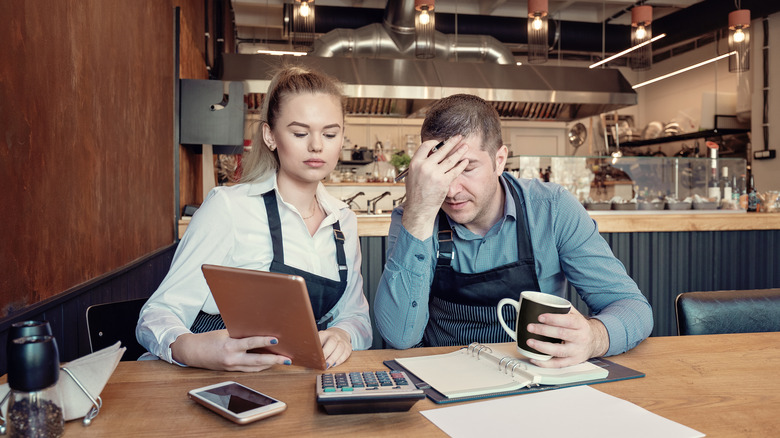Robert Irvine Thinks This Recurring Issue On Restaurant: Impossible Is 'Crazy'
We've all seen the depressing stories on "Restaurant: Impossible:" tired-looking dining rooms, dirty kitchens, apathetic staff, and debt-stricken owners ready to throw in the towel. By the time Robert Irvine and his team show up to try to save a restaurant, it's usually on the brink of closing. In fact, according to Business Insider, the "Restaurant: Impossible" team will only take on a restaurant "mission" if there's "100% chance of imminent failure."
Such desperate restaurants are not hard to find. Citing research from Cornell University and Michigan State, the website Restaurant Owner points out that 27% of new restaurants fail in their first year, 50% fail within three years, 60% were gone within five years, and after 10 years, "70% of the restaurants that had opened for business a decade before had failed." But the most important statistic is this: more than 81% of small businesses failed for reasons that were entirely within the control of their owners. In other words, these failures didn't have to happen.
Robert Irvine knows this well. Episode after episode, the successful chef, restaurant owner, and "Restaurant: Impossible" host doles out tough love to restaurant owners who don't want to look inward to see the reasons for their businesses' failures.
One of those reasons? Willful ignorance of information that's crucial to understanding the health of one's business.
Food and labor costs matter
Restaurant owners usually love food and people, not sitting down with their books to do the accounting that small businesses require. Mundane back office tasks aren't as fun as experimenting with new recipes or making a playlist for your dining room. But "the books" are essential to keeping a restaurant open, even if the task isn't glamorous. And, as Irvine recently tweeted, it's "crazy" how many restaurateurs don't have solid knowledge of these numbers.
Two figures Robert Irvine says struggling restaurateurs ignore are food costs and labor costs. In fact, he told Business Insider, owners' willful ignorance of these figures is one of the top five reasons most restaurants fail.
According to Budget Branders, a menu item's food cost is the ratio of ingredient costs to the revenue it generates when sold, expressed as a percentage. Ideal food costs are between 28% and 35%. Pared notes that, labor, like food, is one of a restaurant's largest costs. Labor cost percentage is the relationship between a restaurant's total amount spent on labor and its total revenue over the same period. Ideally, it should be "below 30% of total revenue."
Irvine told Business Insider that knowing how to make a good dish doesn't keep the doors open. "Potential restaurateurs do not realize or appreciate the specific set of demands that come along with owning and running a restaurant," he said. "Once realized, it is often way too late."

